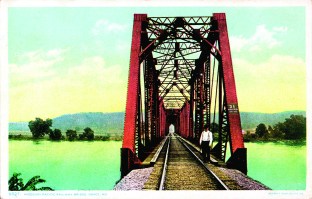The last of three bridges designed by Svedrup and Parcel dynamited and replaced by new span.
December 8, 2014 – Missouri’s highways and transportation commissioner pushed the plunger, detonating dynamite on a 740 foot section of the Hurricane Deck bridge that once carried Highway 5 over the Osage River arm of Lake of the Ozarks. According to the bridgehunter.com website, the 1936 bridge was ‘structurally deficient’ and clearly the highway department agreed. The steel will be pulled out of the lake and the rest of the bridge will be taken down in additional demolitions in coming weeks.
Video from Springfield TV station, KOLR-10, shows the demolition blasts and collapse of the first spans to be dropped into the lake.
Early in the development of the Lake, Sverdrup and Parcel, a St. Louis firm, was engaged to design and construct bridges to connect communities in Morgan and Camden counties that were now cut off from each other. When Damming the Osage was published (2012), the 1936 Hurricane Deck bridge – which was named the most beautiful bridge in its class that year by the American Institute of Steel Construction – was the last remaining span over the lake by that firm. Additional information is available at Bridgehunter.com http://bridgehunter.com/mo/camden/hurricane-deck/
 Leif Sverdrup, a Norwegian immigrant, with his college engineering teacher, John Parcel, founded the company in 1928. During World War II, General Sverdrup became chief engineer for General Douglas MacArthur.
Leif Sverdrup, a Norwegian immigrant, with his college engineering teacher, John Parcel, founded the company in 1928. During World War II, General Sverdrup became chief engineer for General Douglas MacArthur.

Among many distinctive spans, the firm also designed the graceful twin bridges that cross the Missouri River at Jefferson City.
Sverdrup and Parcel also designed the pair of steel-through-arch bridges crossing the Missouri River at Jefferson City (Cole County, Missouri) in 1955. These spans still carry traffic on the multi-lane freeway of US 54/63.
(click on image to enlarge)









 Leif Sverdrup, a Norwegian immigrant, with his college engineering teacher, John Parcel, founded the company in 1928. During World War II, General Sverdrup became chief engineer for General Douglas MacArthur.
Leif Sverdrup, a Norwegian immigrant, with his college engineering teacher, John Parcel, founded the company in 1928. During World War II, General Sverdrup became chief engineer for General Douglas MacArthur.







